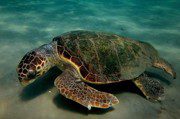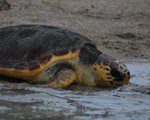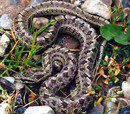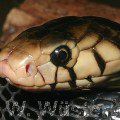
Loggerhead
LOGGERHEAD (Caretta caretta) or big-headed sea turtle, larger than hawksbill, its heart-shaped shell reaches a length of 1 m. The distribution of the loggerhead is as wide as that of other sea turtles, and it can be found in all tropical seas. These turtles swam into the waters of our country twice – in the Barents Sea and in the Far East. He consumes food in the first place – crabs and shellfish, as well as fish, jellyfish, sponges. Occasionally, the loggerhead also eats aquatic plants. The nesting sites of this species are scattered along many coasts of islands and mainlands in the tropics and even beyond.
Additionally
 The meat of this turtle was considered far from being the most delicious, only local tribes eat it, but its eggs were a delicacy. Their unlimited collection has led to a very serious decline in the number of this species of turtles over the past 50-100 years.
The meat of this turtle was considered far from being the most delicious, only local tribes eat it, but its eggs were a delicacy. Their unlimited collection has led to a very serious decline in the number of this species of turtles over the past 50-100 years.
For example, in Colombia, so-called “lollipops” are prepared from loggerhead eggs – a sweet dish. Very often, eggs are used in the production of confectionery.
In Cuba, the eggs of this turtle, obtained from a pregnant individual, were smoked right in the oviducts. Then they were sent for sale, like sausages.
This species of turtle is listed in the Convention on International Trade in Species of Wild Flora and Fauna, and in the Red Book.
Protected by the laws of Cyprus, Greece, USA, Italy
Sources of
http://ru.wikipedia.org
http://www.floranimal.ru
http://www.ecosystema.ru
http://ours-nature.ru
http://www.biodat.ru
Reproduction
During the season, the female makes clutch 4-5 times, mainly at night. The number of eggs in a clutch is from 100 to 126. They are covered with a leathery shell, the diameter of which is about 4 cm. The incubation period lasts 49-67 days.
The offspring is born in 1-2 months, and, spending several hours in the nest, getting out of the sand, they rush to the sea.
Description
 This species is larger than Bisa, its heart-shaped shell reaches a length of 1 m. There are five pairs of costal scutes on the back. The head is massive, with large shields. The upper part protrudes slightly above the lower, but does not have a pronounced beak. The shell is reddish-brown above. The front flippers have two blunt claws. Body weight ranges from 90 to 160 kg.
This species is larger than Bisa, its heart-shaped shell reaches a length of 1 m. There are five pairs of costal scutes on the back. The head is massive, with large shields. The upper part protrudes slightly above the lower, but does not have a pronounced beak. The shell is reddish-brown above. The front flippers have two blunt claws. Body weight ranges from 90 to 160 kg.
The false carriage of the loggerhead is called due to the fact that the shields of the shell of this turtle are unsuitable for the production of crafts and souvenirs.
Food
It mainly prefers to eat crustaceans and molluscs. It also eats fish, sponges, jellyfish. Occasionally, aquatic plants may also be eaten.
Other names
Big-headed turtle, big-headed sea turtle, caretta, false caretta.
Caretta caretta.
Inhabitation
 This species is widespread in the waters of the Atlantic, Pacific and Indian oceans, in the Mediterranean Sea. In Russian waters, the loggerhead can be found in the Far East (Peter the Great Bay) and in the Barents Sea (near Murmansk).
This species is widespread in the waters of the Atlantic, Pacific and Indian oceans, in the Mediterranean Sea. In Russian waters, the loggerhead can be found in the Far East (Peter the Great Bay) and in the Barents Sea (near Murmansk).
Sometimes there are individual representatives who, following the sea currents, swim extremely far beyond the tropics.
Basically, this species lives in the water, on land it appears only to make masonry.
Nests are located in subtropical and temperate regions. The largest group (about 30 thousand females) nests in Oman, on the island of Mezira. Also, large nesting sites are located on the coast of Florida and in Australia.





